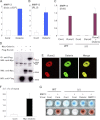Osterix regulates calcification and degradation of chondrogenic matrices through matrix metalloproteinase 13 (MMP13) expression in association with transcription factor Runx2 during endochondral ossification
- PMID: 22869368
- PMCID: PMC3460424
- DOI: 10.1074/jbc.M111.337063
Osterix regulates calcification and degradation of chondrogenic matrices through matrix metalloproteinase 13 (MMP13) expression in association with transcription factor Runx2 during endochondral ossification
Abstract
Endochondral ossification is temporally and spatially regulated by several critical transcription factors, including Sox9, Runx2, and Runx3. Although the molecular mechanisms that control the late stages of endochondral ossification (e.g. calcification) are physiologically and pathologically important, these precise regulatory mechanisms remain unclear. Here, we demonstrate that Osterix is an essential transcription factor for endochondral ossification that functions downstream of Runx2. The global and conditional Osterix-deficient mice studied here exhibited a defect of cartilage-matrix ossification and matrix vesicle formation. Importantly, Osterix deficiencies caused the arrest of endochondral ossification at the hypertrophic stage. Microarray analysis revealed that matrix metallopeptidase 13 (MMP13) is an important target of Osterix. We also showed that there exists a physical interaction between Osterix and Runx2 and that these proteins function cooperatively to induce MMP13 during chondrocyte differentiation. Most interestingly, the introduction of MMP13 stimulated the calcification of matrices in Osterix-deficient mouse limb bud cells. Our results demonstrated that Osterix was essential to endochondral ossification and revealed that the physical and functional interaction between Osterix and Runx2 were necessary for the induction of MMP13 during endochondral ossification.
Figures







References
-
- Kronenberg H. M. (2003) Developmental regulation of the growth plate. Nature 423, 332–336 - PubMed
-
- de Crombrugghe B., Lefebvre V., Behringer R. R., Bi W., Murakami S., Huang W. (2000) Transcriptional mechanisms of chondrocyte differentiation. Matrix Biol. 19, 389–394 - PubMed
-
- Komori T. (2011) Signaling networks in RUNX2-dependent bone development. J. Cell. Biochem. 112, 750–755 - PubMed
-
- Nishimura R., Hata K., Ikeda F., Ichida F., Shimoyama A., Matsubara T., Wada M., Amano K., Yoneda T. (2008) Signal transduction and transcriptional regulation during mesenchymal cell differentiation. J. Bone Miner. Metab. 26, 203–212 - PubMed
-
- Ornitz D. M., Marie P. J. (2002) FGF signaling pathways in endochondral and intramembranous bone development and human genetic disease. Genes Dev. 16, 1446–1465 - PubMed
Publication types
MeSH terms
Substances
LinkOut - more resources
Full Text Sources
Molecular Biology Databases
Research Materials

